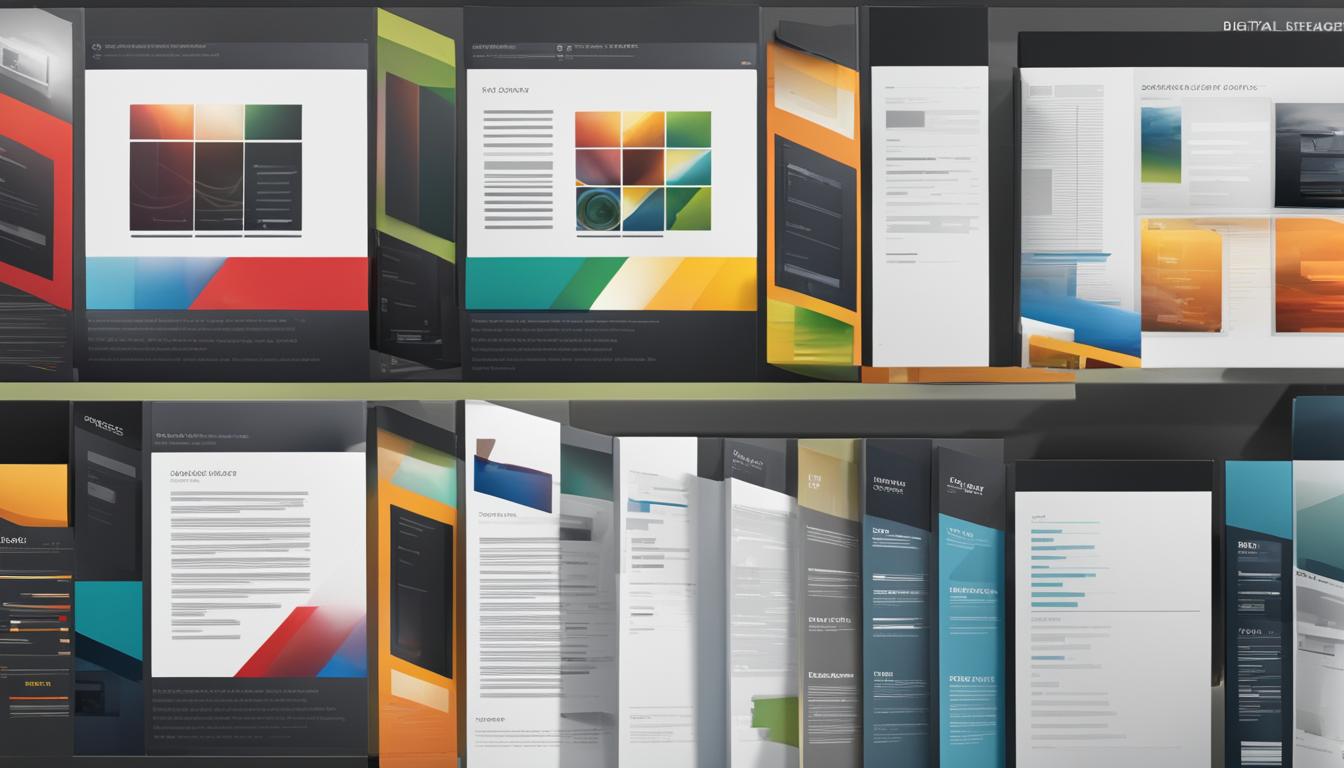Every day, millions of people use Google Images to explore content visually. Image search makes up a significant portion of web queries, with an estimated 27% of all searches across the top 10 US web search properties. Optimizing images for SEO is crucial as it can improve content visibility, drive traffic to your website, and enhance the user experience. Properly naming and describing images, choosing the right image formats, sizes, and dimensions, and hosting and caching images effectively are all key aspects of image optimization for SEO.
Key Takeaways:
- Choosing the right image formats can significantly impact your SEO efforts.
- Consider using JPEGs for photos and PNGs for images with transparency.
- GIFs are best suited for simple animations, while SVGs are great for logos and graphics.
- Optimizing image sizes and dimensions is important for page load times and user experience.
- Properly hosting and caching images can improve site performance.
Properly Naming and Describing Images for SEO
Properly naming and describing images is a simple yet often overlooked optimization opportunity. When it comes to image file names, using relevant keywords is crucial for SEO. Make sure to omit stop words and separate keywords with hyphens to improve search engine visibility. For example, instead of naming an image file “IMG123456.jpg,” consider renaming it to “best-seo-practices.jpg” to include relevant keywords.
In addition to file names, image alt and title attributes play a significant role in SEO. Alt attributes provide textual descriptions of images, which are crucial for users who are visually impaired or have disabled images. They also serve as an opportunity to include relevant keywords related to the image and page content. It is important to write alt attributes in a grammatically coherent and concise manner, ensuring they accurately describe the image.
Title attributes, on the other hand, are used to provide additional context and information about the image. While alt attributes should focus on descriptive content, title attributes can vary and include relevant keywords. However, it is important to avoid keyword stuffing in title attributes. Instead, use them to provide useful information or context that enhances the user experience.
When optimizing images for SEO, don’t forget about on-page image captions and keywords in the surrounding text. Including relevant keywords in image captions and utilizing them in the context of the surrounding text can provide further relevance signals to search engines. These signals help search engines understand the image’s context and improve its ability to rank.
Furthermore, it’s essential to ensure that the host page’s HTML title tags are relevant to the image for better image search results. The HTML title tag serves as a concise representation of the page’s content and can influence search engine rankings. Aligning the HTML title tag with the image’s subject matter helps search engines understand the image’s context and boosts its visibility in relevant searches.
Properly naming and describing images is a crucial step in optimizing them for SEO. By following best practices for image file names, alt and title attributes, and utilizing image captions and keywords strategically, you can enhance your website’s visibility in search engine results and provide a better user experience.
Choosing the Right Image Formats, Sizes, and Dimensions

When it comes to optimizing website images for SEO, selecting the appropriate image formats, sizes, and dimensions is crucial. Let’s explore some key considerations for making the right choices.
Image Formats: JPEG vs PNG vs SVG vs GIF
Choosing the right image format is essential for SEO. JPEGs are generally more SEO-friendly than PNGs, especially if you don’t require transparent backgrounds. Logos and high-resolution graphics can benefit from using the vector-based SVG format. GIFs, on the other hand, should be reserved for simple animations without a wide color scale. For larger animated images, using a video format is recommended.
Image File Size and Compression
Keeping image file sizes under control is crucial for maintaining optimal page load times. Aim to keep file sizes under 100Kb whenever possible. Larger files can be saved as progressive JPGs to enhance page load speeds. Additionally, utilizing image compression tools can help reduce file sizes without significant quality loss, improving both SEO and user experience.
Image Dimensions and Responsiveness
Image dimensions play a vital role in optimizing website images for SEO. Avoid exceeding the maximum width of popular desktop screen resolutions to prevent unnecessary rendering and reduce page load times. To ensure your images look great on all devices, utilize CSS techniques to make them responsive. Plugins or elements such as <picture> and <srcset> can also assist in serving the most optimized image for different screen sizes.
In summary, by selecting the appropriate image formats, keeping file sizes in check through compression, and optimizing dimensions and responsiveness, you can significantly enhance the SEO performance of your website’s images, ultimately providing a better user experience.
| Image Format | Pros | Cons |
|---|---|---|
| JPEG | Good for photos, small file sizes, and widespread compatibility | Lossy compression can lead to reduced image quality |
| PNG | Supports transparency and lossless compression | Larger file sizes than JPEG |
| SVG | Vector-based, retains quality at any size, and smaller file sizes | Not suitable for complex images or photographs |
| GIF | Supports simple animations and relatively small file sizes | Limited color capabilities and not suitable for complex graphics |
Properly Hosting and Caching Images

Properly hosting and caching images is crucial for optimizing page load times and enhancing overall site performance. Large image file sizes can significantly slow down the loading speed of your web pages and increase the number of requests made to the server, which can affect the loading of other critical resources. To ensure a smooth user experience and improve SEO, it’s important to implement effective hosting and caching practices for your website’s images.
Hosting Images on Your Domain
When hosting images, it is recommended to store them on your domain or a subdomain of your website. This allows you to have better cache control and control over redirects. By hosting the images on your own domain, you can also brand the image URLs and ensure that they are associated directly with your website. This is particularly important when it comes to SEO and maintaining the value of backlinks from other websites.
Hosting images on your domain also benefits your server’s load as it reduces unnecessary requests to third-party image hosting platforms. It allows you to have full control over the server performance and ensures that your website’s images are always available to users.
Third-Party Image Hosting via Content Delivery Networks
In some cases, hosting images on third-party sites can be advantageous, especially for websites with a global audience. However, it is recommended to use a content delivery network (CDN) for image hosting. CDNs distribute your images across different servers located in various geographic locations. This allows for faster delivery of images to users, as the images are served from a server closest to the user’s location.
When utilizing third-party image hosting via CDN, it is advisable to link the CDN to a custom subdomain. This not only helps with branding but also ensures ease of switching between different CDN providers in the future without requiring multiple changes to image URLs.
HTTP/2 and Server Expirations
Enabling HTTP/2 for subdomains or third-party CDNs is essential for smooth and efficient image hosting. HTTP/2 allows for multiple concurrent server requests, improving the overall performance and load times of your website.
Additionally, setting appropriate server expirations for image caching can also boost site performance. By specifying server expirations, you can control how long browsers should cache images, reducing the need for repeated image requests and improving overall page load times.
| Benefits of Proper Hosting and Caching | Best Practices |
|---|---|
| 1. Improved page load times | 1. Host images on your domain or subdomain |
| 2. Enhanced user experience | 2. Utilize a content delivery network (CDN) |
| 3. Reduced server load | 3. Enable HTTP/2 for image hosting |
| 4. Set server expirations for image caching |
Properly Loading Images on Your Pages

When it comes to optimizing your website for SEO, image loading speed plays a vital role. Slow-loading images can negatively impact user experience and even affect your search rankings. To ensure your images load quickly and efficiently, there are several key strategies you can implement.
Lazy Loading Images for SEO
Lazy loading is a technique that loads images only when they are visible to the user. This means that images below the fold, or images that are not immediately visible when the page loads, are loaded as the user scrolls down. Lazy loading can significantly improve page loading speed, especially for media-heavy articles and image galleries.
Infinite Scroll and Paginated Loading for SEO
Implementing infinite scroll or paginated loading can also improve image loading speed. With infinite scroll, new images are loaded dynamically as the user continues to scroll down the page. Paginated loading divides content into multiple pages, reducing the overall load on each page and improving the speed at which images load.
Image Sitemaps and Structured Data for SEO
In addition to optimizing image loading speed, image sitemaps and structured data can greatly benefit your SEO efforts. Image sitemaps help search engines discover and crawl your images, increasing the likelihood of your images appearing in search results and image carousels. Structured data can further enhance the indexing of your images, making them more prominent in search results, such as rich results or image-specific features.
Proper Image Dimensions and Tags for SEO
To ensure that your images load properly and quickly, it’s important to scale them to their actual display size. This helps avoid unnecessary bytes and optimizes the loading speed. Additionally, using proper image tags, such as the HTML tag, allows search engines to index and understand the content of your images for better ranking and visibility.
Avoid using “Section:” or “Table:” in the title of H2 and Table.
Robots.txt Rules for Image Crawling
Make sure that your robots.txt file does not prevent search engine crawlers from accessing and indexing your images. Incorrectly configured robots.txt rules can hinder your image SEO efforts and prevent search engines from properly crawling and indexing your images.
By implementing these strategies, you can optimize your image loading speed, improve user experience, and enhance your website’s SEO performance.
How to Audit Images on Your Site
As site owners, developers, and webmasters, it’s important to regularly audit the images on our websites to ensure optimal performance and user experience. One effective way to do this is by sorting the image folders by size. This allows us to easily identify any large image files that may be negatively impacting the site’s speed and performance.
Once we’ve identified these large files, it’s crucial to optimize them for smaller file sizes. This can be achieved using various image compression tools available in the market. Some popular options include GIMP, TinyPNG, Smush, and MinifyWeb. These tools can help us reduce the image file sizes without compromising on quality, thereby improving site speed and overall user experience.
In addition to optimizing file sizes, it’s also important to ensure that the EXIF and IPTC metadata of our images are optimized. This metadata provides valuable information about the images and can further enhance their visibility in image search results.
By regularly auditing and optimizing our website images, we can not only improve the overall performance of our site but also enhance its visibility in search engines. So, don’t forget to dedicate some time to this essential task and enjoy the benefits it brings to your site’s SEO.










